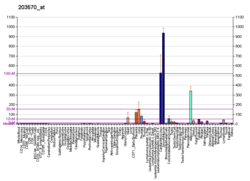Top Qs
Timeline
Chat
Perspective
LOXL1
Protein-coding gene in the species Homo sapiens From Wikipedia, the free encyclopedia
Remove ads
Lysyl oxidase homolog 1, also known as LOXL1, is an enzyme which in humans is encoded by the LOXL1 gene.[4][5]
Remove ads
Function
This gene encodes a member of the lysyl oxidase gene family. The prototypic member of the family is essential to the biogenesis of connective tissue, encoding an extracellular copper-dependent amine oxidase that catalyses the first step in the formation of crosslinks in collagens and elastin. A highly conserved amino acid sequence at the C-terminus end appears to be sufficient for amine oxidase activity, suggesting that each family member may retain this function. The N-terminus is poorly conserved and may impart additional roles in developmental regulation, senescence, tumor suppression, cell growth control, and chemotaxis to each member of the family.[4]
Remove ads
Clinical significance
Polymorphisms of the LOXL1 gene are associated with pseudoexfoliation syndrome, a disease where the extracellular matrix contains abnormal amounts of cross-linked, amyloid-like fibrillar material and glycoproteins. When this happens in the eye, exfoliation glaucoma results.[6][7]
Interactions
See also
References
Further reading
Wikiwand - on
Seamless Wikipedia browsing. On steroids.
Remove ads



